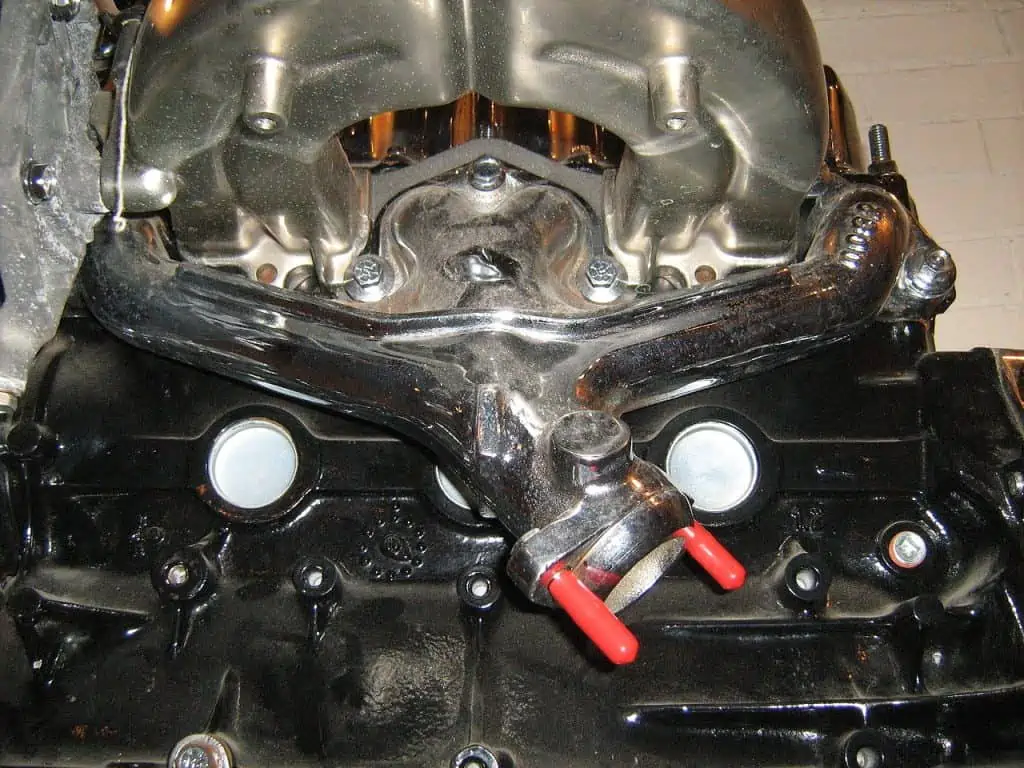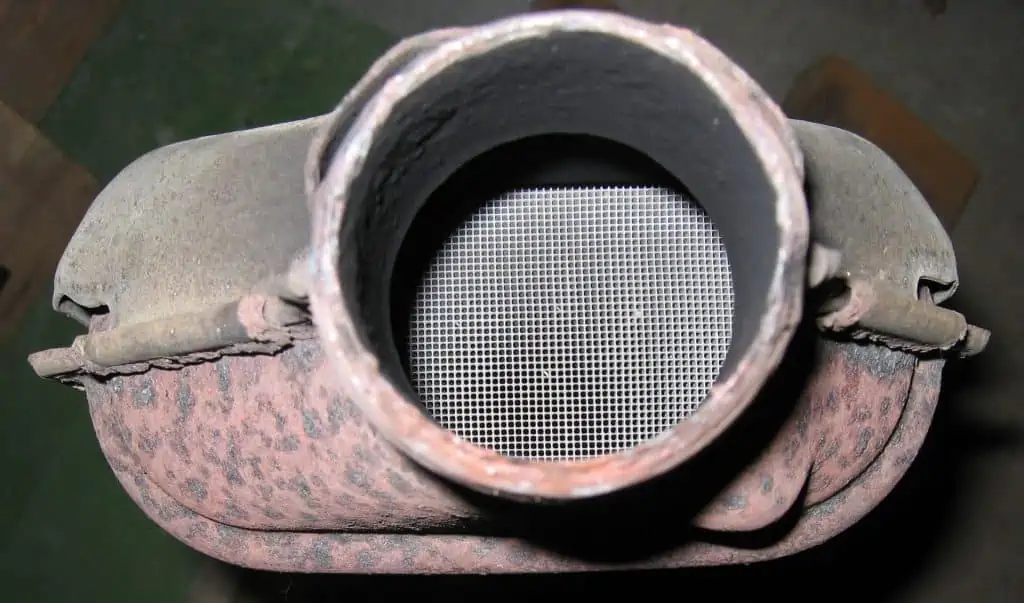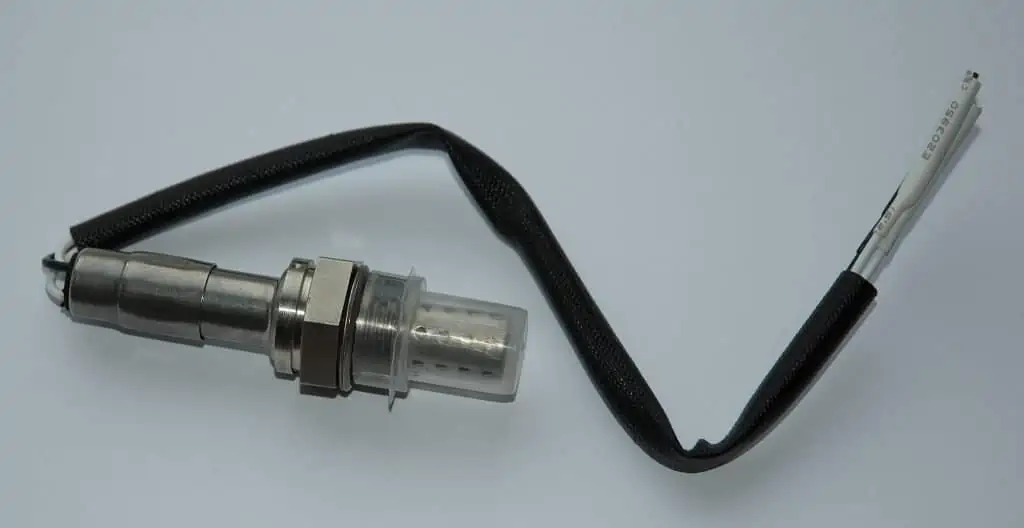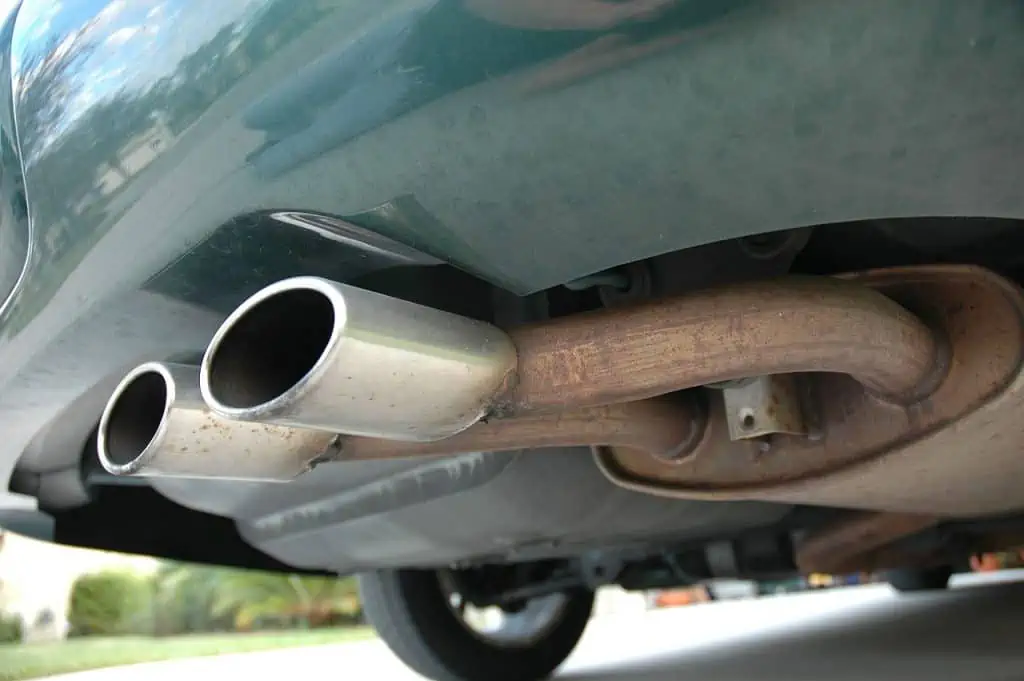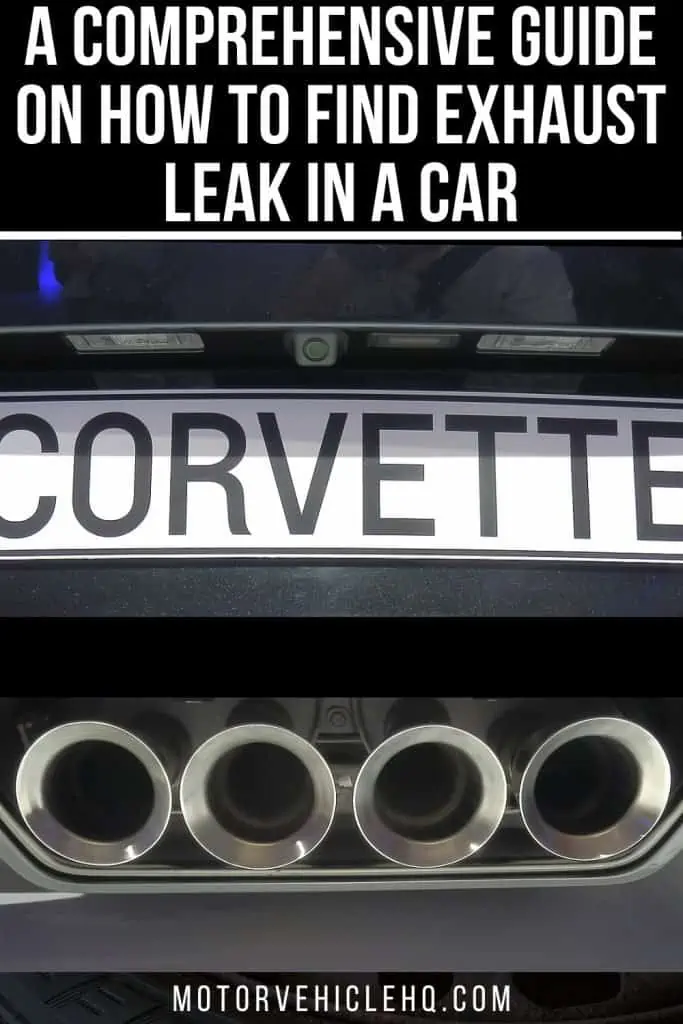It’s never a good idea to overlook exhaust leaks. Rarely, they can merely make a loud noise while you’re driving, but they may also be hazardous if they are near the gasoline or other flammable parts of your vehicle, or if they are seeping into the cabin.
Large enough exhaust leaks have the potential to alter a car’s back pressure and ultimately its performance. This is why it’s crucial to understand how to locate an exhaust leak. The good news is that there are quick and simple techniques to check for leaks and identify their source.
Your car’s exhaust system serves a comparatively straightforward purpose, but there are instances when it does so in a convoluted way. The primary function of a vehicle’s exhaust system is to send the gases emerging from the combustion chamber to a secure location.
The area outside of your vehicle, away from you and any openings like windows, is the safest place to be. Typically, this refers to a location below the rear bumper.
The secondary function of the exhaust system is to block out the noise of the engine’s internal explosions and the sound of the high-velocity gases leaving the tailpipe. When you consider the path that the exhaust must travel, it becomes tricky.
Remember that it can get really hot. Depending on whether you are downshifting, idling, or accelerating strongly while you are driving, the engine also moves about a little bit and rattles.
This is why your exhaust system must securely transport hazardous gasses to the back of the car quickly and quietly without overheating anything. To do this, the exhaust system makes use of various manifolds, pipes, heat shields, couplings, mufflers, flexible unions, and rubber hangers.
Exhaust System: What Does It Do?
Gases are created inside the engine through interactions. The necessity to discharge these gases is due in large part to one particularly dangerous consequence (carbon dioxide). Because of this, your car’s exhaust system and pipes are there to direct gas emissions from the engine down to the exhaust pipes.
When you start your engine and notice an unpleasant sound coming from your engine bay, such as tickling or puffing, you may have an exhaust manifold gasket leak. The gasket is situated between your exhaust manifold and cylinder head.
Gasses might escape along the road through any cracks or leaks, releasing them closer to you and your lungs.
Additionally, exhaust systems contribute to quieting down the noises of gasses interacting by muffling them slightly. Your exhaust pipes begin to work diligently to keep your car running and dangerous gasses far away as you accelerate, decelerate, or encounter a particularly bright day, making them a crucial component of your car.
Fact Check on Exhaust Leaks
Exhaust leaks can occasionally be more than just the obnoxious noise you sometimes hear when starting or operating your car. If the leaks are close to your fuel lines or any other combustible parts of your vehicle, or if the exhaust is entering the cabin of your car, it is quite dangerous.
The performance of your car will be impacted, and the backpressure will vary if the leak is large enough. In addition to these risks, breathing in exhaust fumes from an exhaust leak is extremely harmful to human health.
Because of this, it’s essential to understand the signs of an exhaust leak, where to look for one, and how to fix one yourself (if you’re a DIY enthusiast). Let’s take a quick look at the warning signs of an exhaust leak.
What are the Common Symptoms of an Exhaust Leak?
Your vehicle’s exhaust system is there for your health and safety. Poisonous gas is released into your car’s interior if your exhaust system leaks for any cause or sustains damage.
When these gases are inhaled, they have an impact on both the driver’s and the passengers’ health. It would be preferable if you went to see your technician as soon as you noticed an exhaust system leak.
1. Disturbingly Loud Noises
An exhaust manifold gasket leak can be detected when you crank on your engine and hear an unflattering noise, such as tickling or puffing, emanating from your engine bay. The gasket is located between your cylinder head and exhaust manifold. The exhaust flange joint is another potential source of this noise.
2. Very Strong Smell
There will be a distinct smell in the air if there is a leak anywhere in your exhaust system, particularly close to the catalytic converter. The stench might be carbon monoxide from your exhaust system if it persists for a while.
You must avoid it at all costs since it has the potential to be fatal. When driving and smelling this scent, put your glasses on wind-down.
3. Reduced Fuel Efficiency
Your car’s efficiency will drop by 3 to 4 mpg if an exhaust leak develops near the exhaust manifold. This is because the O2 sensor, which detects the flow of oxygen into and out of your exhaust system, gets bypassed by the exhaust.
Your vehicle uses more gasoline as a result. To avoid wasting money on petrol refills, examine your exhaust as soon as you observe poor fuel efficiency.
Chevrolet Corvette C7 Exhaust Pipes by Alexander Migl / CC BY-SA 4.0. As you accelerate, decelerate, or come across a particularly sunny day, your exhaust pipes start to work furiously to keep your car functioning and toxic gasses far away, making them an essential feature of your car.
4. Vibration and Crashy or Tickling Sound
When you hear a scratchy, tickling, tapping sound in your engine compartment or below your car when you accelerate, you know you have an exhaust leak. No matter how much of a leak there is, the escaping gasses might produce vibration or noise.
Major leaks, though, might make your steering wheel vibrate and make unpleasant noises. Additionally, you note that when you accelerate, the exhaust leak sound gets louder.
How to Find Exhaust Leak In a Car
Finding the source of the leak is the next step once you have confirmed that your exhaust leaks. This article will clearly explain how to use these straightforward techniques to identify the source of the leak.
When trying to isolate a leak, it is advisable to wait until the car has cooled off because exhaust pipes can get quite hot. When your vehicle is still warm after the operation, avoid touching the exhaust system. Follow these instructions to learn how to locate an exhaust leak:
1. Perform a Visual Inspection
If you have ever worked on your exhaust system or disconnected it in any manner while working on other components of your car, you should first ask yourself if you have an exhaust leak. If so, you need to visually check the spaces you worked in. Check for cracks in the exhaust pipe and double-check the gaskets, joints, and other components.
Notably, your car’s exhaust system heats up more than any other part. When the exhaust is hot, avoid touching it with your fingers since it might cause them to burn off.
2. Use a Rag to Block the Exhaust Tailpipe
While this approach may seem novel, it is effective. If your exhaust is leaking, the leaky regions are likely to be filled with black exhaust smoke. Sometimes it’s difficult to pinpoint the source of an exhaust leak.
Lifting your car off the ground is the first step. Lift your vehicle with a floor jack or a car lift. Make sure the vehicle is raised so you can easily go underneath it. Support your car using jack stands on the front and back sides in addition to the jack.
Raising your vehicle will allow you to see your exhaust system more clearly. You can rapidly check your exhaust system that way. Here’s the trick: start your car and let it idle for a while.
You’ll want assistance to cover the exhaust tailpipe with a rag while your engine is running. Ask a helper to tightly cover and hold the exhaust tailpipe.
This will make the leak more noticeable so you can find the exact location of the leak with ease.
Check the exhaust gasket between the cylinder head and the exhaust manifold and look for cracks in the manifold.
Be aware that the muffler’s bottom has a little leak. That is typical. Small holes in the muffler enable water to escape. Thus, don’t assume that these holes are not intended to be present.
These holes are designed to let water out. The muffler will corrode if the water doesn’t drain quickly enough and collects there instead. To check the exhaust manifold and the flange junction, also known as the exhaust neck, easily when using this approach, the exhaust heat shield on the manifold must be removed.
Catalytic converter from a car exhaust by The RedBurn / CC BY-SA 3.0. A loose exhaust system will affect the O2 sensor measurement. If your car’s computer is flashing a message indicating a damaged or malfunctioning catalytic converter, you should fix the exhaust leak and run a new diagnostic on it.
3. Utilize Soapy Water
This technique describes in clear terms how to locate exhaust leaks using soapy water. What you need in this situation is a leaf blower, an air compressor with gloves and tapes, or anything that can push air into the exhaust system along with some soapy water in a spray bottle.
Place your leaf blower firmly into the exhaust tailpipe of your vehicle. Tape can be used to support it. Depending on which one you’re using, start the air compressor or leaf blower. Grab a spray bottle, and spritz the questionable spots with soapy water.
This approach is an alternative if you’re trying to figure out how to locate an exhaust manifold leak. When you spray soapy water over a surface, if you see bubbles there, it means your exhaust is leaking from that location.
When bubbles appear in one area, you do not need to stop spraying the soapy water, though. Your exhaust is probably leaking in many places. Don’t worry if you’re over-spraying it with soapy water; there is no such thing as too much of it.
What are the Common Areas for Exhaust Leaks?
- Check the exhaust manifold by opening the hood (if you can see it). It is often protected with a heat shield. An exhaust manifold has three locations where the leak or leaks might be located. When it splits, it may seep into the manifold itself. Additionally, the mounting surface (gasket) where it connects to the engine and the gasket where the downpipe is attached are both susceptible to leaks.
- Near the top of the manifold, pay close attention. Look for a distinct in-rhythm ticking noise. This is often how a leak sounds. Sometimes an engine knock might be mistaken for an exhaust leak at the manifold. However, most often it’s an exhaust leak. The downpipe or the flange gasket connecting the manifold to the catalytic converter may be the source of a ticking noise coming from lower on the engine. It is very advised to position the vehicle on the ramps.
- Under the vehicle, a lot of typical exhaust components can malfunction. A flex pipe is commonly seen in the exhaust system of autos. An accordion-like flexible metal inside of this type of pipe is encased in a woven stainless steel fabric. Over time, this flex pipe may deteriorate and leak. A damaged flex pipe is simple to spot and makes a lot of exhaust noise.
- The problem of flexible flange joints is another typical one. The majority of flexible exhaust couplings have a spring flange and a large “donut” gasket that allows them to bend as the vehicle travels. These flexible joints frequently degrade, and generally, the donut gasket is the culprit. Although a rigid joint can also break down, this happens less frequently than with flexible joints.
- Muffler and catalytic converter failures are also frequent. Check for any holes or areas where the muffler has corroded through or broken apart. The internal honeycomb element of a catalytic converter typically breaks down and causes the device to malfunction. It then begins to shake. Secondary mufflers called resonators are equally susceptible to corrosion, failure, and breakage.
- Keep a close eye on the exhaust pipe throughout the examination to see if there is significant corrosion present or if any rubber hangers have snapped. While most OEM exhaust systems produced in the past 15 years are constructed of stainless steel, some are not. On the pipe, pay attention to any areas where there is a significant quantity of rust since these areas might quickly fail. Gently squeeze such areas with a pair of strong pliers. The pipe is quite thin and needs care when it flexes or compresses.
The engine block of a BMW M20 straight-six engine by Liftarn / CC BY 2.5. When you accelerate, you can tell you have an exhaust leak if you hear a scratchy, tickling, or tapping sound in your engine compartment or below your car. No matter how big the leak is, the leaking gasses could cause noise or vibration.
NOTE: When the vehicle is cold, simply check. Listen and look for connections on the exhaust pipe. The air around the pipe connection may be carefully felt with your palm since the vehicle is chilly. Don’t, however, touch. The air will start to pulse out of the leak’s location.
Black soot is a typical indicator of an exhaust leak at any location. There is a leak when it is visible on any part of the pipe, the muffler, any pipe connector, or other parts.
How Do You Cure an Exhaust Leak Using a DIY Method?
I’ve been successful in outlining the signs of exhaust leaks and the three straightforward techniques for finding them.
What’s next? Let’s examine three straightforward techniques for repairing exhaust leaks at home.
Concentrate your attention there once you have identified the source of the leak.
I’d suggest using three separate items to complete the remedy. The first is a high-temperature exhaust patch, which seals the leak by being pushed into the crack and hardening like steel.
The muffler bandage is the second item, and you may use it to cover the leaky region. It hardens and becomes steel-like in texture. The exhaust clamp, the finished item, covers the leaky region and, when tightened, closes it off.
Pretty about everything you require to fix your exhaust at home will be covered by these goods. You’ll also want a mechanic’s toolbox, which should include hand gloves, sandpaper, tape, and a metal wire brush.
Just go buy it once you’ve determined which product is best for you. These goods are available through the Google Store. They are incredibly affordable and simple to use.
Let’s get started on repairing your exhaust leak at home right away. A high-temperature exhaust patch, the first item advised, is frequently used to stop leaks in exhaust pipes and manifolds.
Grab your sandpaper and wire brush and clean the spots that are leaking before applying this. Scratch any small pieces of metal or other debris from the surface you intend to use for the exhaust temperature patch.
Get some alcohol and wash the surface after cleaning it. Make sure there is no corrosion, dirt, or debris on it. You’ll achieve a decent banding surface in this manner.
If you discovered the leak using an air compressor or leaf blower, turn it around and turn it on to draw air from your exhaust system. Mix your temporary exhaust patch while pulling the air out of your exhaust system, then apply it to the cleaned surface.
The exhaust leak will be effectively sealed as a result. If an air blower is not available, you can still apply the patch right after cleaning the surface.
You must now wait for it to dry, which might take anywhere between two and four hours. A heat gun may be used to quickly dry it. Do not start the engine until you are finished, under any circumstances. Before starting your car, remove the leaf blower.
The last techniques employ an exhaust clamp or bandage, as appropriate. Most exhaust pipes are treated using these techniques. You may use your exhaust clamp to cover the leaky location and tighten it if you discover an exhaust pipe leak.
Alternatively, you might use exhaust bandages to seal the leaky locations. To do this, switch on the engine and let it idle for a minimum of two minutes with the exhaust hot.
Oxygen sensor by Mnemo / CC BY-SA 3.0. The presence of an exhaust leak may cause erroneous oxygen sensor readings. The oxygen sensor monitors the amount of oxygen in the exhaust. The sensor might use more gasoline if there is an exhaust leak that causes the fumes to include an excessive amount of oxygen.
Grab the bandage as soon as your exhaust starts to heat up, then cover the leaky locations with it. Make sure the bandage is wrapped as flatly as you can. Maintain a tight fit. Run your heat-generating device back and forth.
What Is the Cost of Fixing an Exhaust Leak?
Your car’s parts will cost you a certain amount to fix, which will depend on the extent of the damage plus labor. Numerous variables, such as the region you’re in and the anticipated completion time, affect labor. Search for a contractor who won’t charge you an arm and a leg for work by comparing their prices to those of the competitors.
How much does it cost to fix an exhaust leak, labor costs aside? It might cost as little as $30 or as much as $400. The degree of your leak is the cause of the variations in prices. There are many different leaks, and each one may have a distinct impact on your vehicle. You’re evaluating the following to order them from least to most serious:
- Sealant application
- The replacement of the exhaust pipe
- Replacing your car’s exhaust pipe and any other broken parts (engine, transmission, radiator)
The brand, model, year, number of cylinders, and location of the repair all have a role in how much it will cost to correct an exhaust leak. An exhaust leak may be fixed in one to two hours. Most dealerships bill between $70 and $100 per hour. Therefore, you should budget a little bit more for an exhaust leak servicing price.
It’s usually a good idea to keep an eye out for indicators of an exhaust leak and stop them before they might harm other elements of your vehicle because the cost rises with severity. If you don’t have the issue fixed right away, things like your engine, transmission, and radiator might suffer significant damage.
Is Driving Possible with an Exhaust Leak?
It is not advised to keep driving your vehicle with an exhaust leak even though it is feasible to do so. You may tolerate and just put up with the poor gas economy, sounds, and vibrations, but you cannot take any risks with carbon monoxide.
The interior of your vehicle is not airtight, so carbon monoxide can slowly start to creep in but has a hard time getting out, contrary to what you may believe, keeping you safe from poisonous exhaust fumes inside. With some exposure to exhaust fumes, you might experience headaches, lightheadedness, or weariness.
While prolonged exposure to carbon monoxide might potentially result in death, dizziness can easily trigger an accident. Roll your windows down and get to a muffler or vehicle repair shop if you notice any of the above-mentioned symptoms, especially if you smell exhaust fumes.
Do Exhaust Leaks Lead to Check Engine Lights?
Yes, that’s possible. Both the check engine light and inaccurate oxygen sensor readings may come on as a result of an exhaust leak. The oxygen sensor, as its name suggests, keeps an eye on the oxygen content of the exhaust.
A leak in the exhaust system may result in excessive oxygen concentrations in the fumes, which would cause the sensor to increase fuel usage.
The check engine light by Wikiuser100000 / CC BY-SA 3.0. An exhaust leak may cause the check engine light and erroneous oxygen sensor readings to illuminate. The oxygen sensor monitors the amount of oxygen in the exhaust. A leak in the exhaust system may cause the sensor to use more gasoline because of the increased oxygen concentrations in the fumes.
An Exhaust Leak: Will It Throw a Code?
The O2 sensor measurement will be impacted by a poorly tightened exhaust system. As a result, you should correct the exhaust leak and re-diagnose your vehicle if the computer in your vehicle is flashing a message that denotes a broken or failing catalytic converter. Your exhaust system may have other problems. Your exhaust system has to be fixed initially if you want to prevent complex problems.
Exhaust Leaks: The Causes and Preventive Measures
The two most frequent sources of exhaust leaks are exhaust systems with rust corrosion and often driving on bumpy roads. Regularly traveling on rough roads will make your car bounce and bump, which might erode the structural integrity of the exhaust components.
In the meantime, the exhaust system’s components will become more prone to holes and leaks due to corrosion and rust.
Additionally, if one of the hangers holding the exhaust system in place separates or the rubber isolator piece becomes worn out, other parts might also be harmed. Because no hangers are holding the exhaust system in place, driving will cause frequent vibrations and impacts that might cause leaks in other parts.
1. Corrosion
Your exhaust is perpetually fixated on the ground. It experiences extremes of heat and cold, rain and snow, is covered in gravel, is sprayed with road tar, and is submerged in the oil that has leaked from other vehicles. Although stainless steel can withstand a lot, ultimately rust will start to affect your exhaust.
2. Impacts on the Exhaust Body
Not everyone drives on perfectly flat pavement, and your exhaust is underneath your vehicle. The low-hanging exhaust system might be damaged by potholes or other road hazards. It could also be struck by stray vehicle debris.
3. Broken Gaskets
Over time, gaskets, like the ones between the manifold and the engine, can deteriorate and lead to uneven surfaces that invite leaks.
4. Bad Welds
It can cause new leaks if the exhaust was previously fixed incorrectly.
5. Age and Time
Everything finally fail. Sometimes your exhaust needs to stop because it has worked hard.
How therefore may exhaust leaks be avoided?
Routine checkups by your trusted technician are your best bet for avoiding exhaust leaks and the difficulties they cause. An experienced technician should be able to see early signs of wear and tear that might result in exhaust leaks before they develop into more serious, expensive problems.
Dual tailpipes attached to the muffler by Steevven1 / CC BY 2.5. The maintenance of your vehicle’s smooth operation depends on the exhaust pipe. Additionally, it keeps you away from potentially harmful fumes to your health. Therefore, it’s crucial to maintain your exhaust pipes and check them for leaks regularly.
Resist Being Surprised!
Your exhaust pipe is crucial to maintaining the smooth operation of your vehicle. Additionally, it prevents you from being close to fumes that can be damaging to your health. Because of this, maintaining your exhaust pipes and regularly checking for leaks is essential.
You may be better prepared in case something happens and you need a speedy remedy by knowing how much it costs to fix an exhaust leak.
Always keep an eye out for leaks, and if you do, patch them up right away. To prevent other components of your vehicle from being harmed, you should still take it to a professional even if you decide to patch it up.
To ensure that your vehicle operates well, you must take care of it. Keep yourself and your vehicle safe from dangerous pollutants by inspecting your exhaust pipes.
The Conclusion
You should get an exhaust leak looked out for as soon as there is any hint of one. Before acting, you shouldn’t wait for all the symptoms to manifest.
You may also do a temporary repair if you know how to locate an exhaust leak. When you take your vehicle to a repair facility with an exhaust leak, don’t forget to roll the windows down.
You’ve seen the three techniques for locating exhaust leaks, their signs and symptoms, and the steps for repairing them. I think you are an expert at this point thanks to the assistance of this essay and the visual presentations.

Chevrolet Corvette C7 Exhaust Pipes by Alexander Migl / CC BY-SA 4.0

Jim Wicks is the founder of MotorVehicleHQ. With over two decades of experience in the automotive industry and a degree in Automotive Technology, Jim is a certified car expert who has worked in various roles ranging from a mechanic, car dealership manager, to a racing car driver. He has owned more than 20 cars over the past 15 years. Ask him about any vehicle you see on the road and he can tell you the make, model and year. He loves the aesthetics of all things cars, and keeps his vehicles in pristine condition.
In his free time, Jim enjoys getting his hands dirty under the hood of a classic car or taking long drives along the country roads. His favorite car? A 1967 Shelby GT500, a true classic that, according to Jim, “represents the pure essence of American muscle.”
